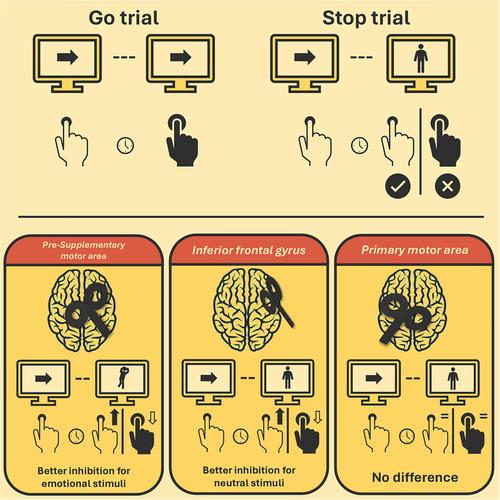当前位置:
X-MOL 学术
›
Ann. N. Y. Acad. Sci.
›
论文详情
Our official English website, www.x-mol.net, welcomes your feedback! (Note: you will need to create a separate account there.)
The role of pre-supplementary motor cortex in action control with emotional stimuli: A repetitive transcranial magnetic stimulation study
Annals of the New York Academy of Sciences ( IF 4.1 ) Pub Date : 2024-05-15 , DOI: 10.1111/nyas.15145 Simone Battaglia 1 , Claudio Nazzi 1 , Chiara Di Fazio 1 , Sara Borgomaneri 1
Annals of the New York Academy of Sciences ( IF 4.1 ) Pub Date : 2024-05-15 , DOI: 10.1111/nyas.15145 Simone Battaglia 1 , Claudio Nazzi 1 , Chiara Di Fazio 1 , Sara Borgomaneri 1
Affiliation

|
Swiftly halting ongoing motor actions is essential to react to unforeseen and potentially perilous circumstances. However, the neural bases subtending the complex interplay between emotions and motor control have been scarcely investigated. Here, we used an emotional stop signal task (SST) to investigate whether specific neural circuits engaged by action suppression are differently modulated by emotional signals with respect to neutral ones. Participants performed an SST before and after the administration of one session of repetitive transcranial magnetic stimulation (rTMS) over the pre-supplementary motor cortex (pre-SMA), the right inferior frontal gyrus (rIFG), and the left primary motor cortex (lM1). Results show that rTMS over the pre-SMA improved the ability to inhibit prepotent action (i.e., better action control) when emotional stimuli were presented. In contrast, action control in a neutral context was fostered by rTMS over the rIFG. No changes were observed after lM1 stimulation. Intriguingly, individuals with higher impulsivity traits exhibited enhanced motor control when facing neutral stimuli following rIFG stimulation. These results further our understanding of the interplay between emotions and motor functions, shedding light on the selective modulation of neural pathways underpinning these processes.
中文翻译:

前补充运动皮层在情绪刺激动作控制中的作用:重复经颅磁刺激研究
迅速停止正在进行的运动对于应对不可预见的和潜在危险的情况至关重要。然而,涉及情绪和运动控制之间复杂相互作用的神经基础却很少被研究。在这里,我们使用情绪停止信号任务(SST)来研究与中性信号相比,情绪信号对动作抑制所涉及的特定神经回路是否有不同的调节。参与者在前补充运动皮层 (pre-SMA)、右额下回 (rIFG) 和左初级运动皮层 (lM1) 进行一次重复经颅磁刺激 (rTMS) 之前和之后进行 SST )。结果表明,当出现情绪刺激时,rTMS 相对于 pre-SMA 提高了抑制特强行为的能力(即更好的行为控制)。相比之下,rTMS 对 rIFG 促进了中性环境中的行动控制。 lM1 刺激后未观察到任何变化。有趣的是,具有较高冲动性特征的个体在 rIFG 刺激后面对中性刺激时表现出增强的运动控制能力。这些结果进一步加深了我们对情绪和运动功能之间相互作用的理解,揭示了支撑这些过程的神经通路的选择性调节。
更新日期:2024-05-15
中文翻译:

前补充运动皮层在情绪刺激动作控制中的作用:重复经颅磁刺激研究
迅速停止正在进行的运动对于应对不可预见的和潜在危险的情况至关重要。然而,涉及情绪和运动控制之间复杂相互作用的神经基础却很少被研究。在这里,我们使用情绪停止信号任务(SST)来研究与中性信号相比,情绪信号对动作抑制所涉及的特定神经回路是否有不同的调节。参与者在前补充运动皮层 (pre-SMA)、右额下回 (rIFG) 和左初级运动皮层 (lM1) 进行一次重复经颅磁刺激 (rTMS) 之前和之后进行 SST )。结果表明,当出现情绪刺激时,rTMS 相对于 pre-SMA 提高了抑制特强行为的能力(即更好的行为控制)。相比之下,rTMS 对 rIFG 促进了中性环境中的行动控制。 lM1 刺激后未观察到任何变化。有趣的是,具有较高冲动性特征的个体在 rIFG 刺激后面对中性刺激时表现出增强的运动控制能力。这些结果进一步加深了我们对情绪和运动功能之间相互作用的理解,揭示了支撑这些过程的神经通路的选择性调节。











































 京公网安备 11010802027423号
京公网安备 11010802027423号